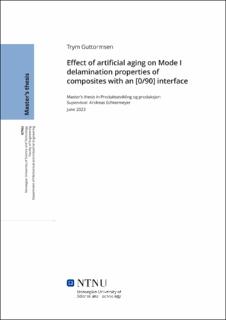| dc.contributor.advisor | Echtermeyer, Andreas | |
| dc.contributor.author | Guttormsen, Trym | |
| dc.date.accessioned | 2023-09-30T17:20:31Z | |
| dc.date.available | 2023-09-30T17:20:31Z | |
| dc.date.issued | 2023 | |
| dc.identifier | no.ntnu:inspera:146039120:91253615 | |
| dc.identifier.uri | https://hdl.handle.net/11250/3093292 | |
| dc.description.abstract | Masteroppgaven er skrevet i samarbeid med Norges teknisk-naturvitenskapelige universitet
(NTNU) i Trondheim, med Andreas Echtermeyer som veileder. Målet med arbeidet og oppgaven er å få en bedre forståelse av hva slags effekt kunstig aldring har på Mode I delaminering av polymerkompositter. Hvordan aldring påvirker materialet ble testet gjennom både dynamisk og statisk testing. Interessen av å bruke kompositter i nye og innovative design er økende, og det er derfor viktig å ha en god forståelse av hvordan kompositter blir påvirket av miljøet det skal brukes i.
Masterprosjektet er en videreføring av et fordypningsprosjekt som ble gjennomført på høstsemesteret 2022. I fordypningsprosjektet var fokuset å lære hvordan å produsere komposittprøver og bestemme hvilke testmetoder som gir best mulig resultater og hvordan disse utføres. Siden dette er en videreføring av et tidligere prosjekt er noen deler av oppgaven basert på det forrige arbeidet, og noen figurer er derfor også de samme som i forrige prosjekt.
Komposittprøvene som ble testet er laget ved å bruke \acrfull{vart} metoden, med en fiberorientering på [0/90/0/90/0/90]. Materialene brukt under produksjon av prøvene var glassfiber og epoxy. Fiberorienteringen til prøvene resulterer i en Mode I-delaminering i grensesnittet mellom et 0 ̊-lag og et 90 ̊-lag. Delamineringsresultater i [0/90]-grensesnittet er av interesse, fordi delamineringsresultater vanligvis oppnås ved å teste kompositter der alle fibrene er i samme retning.
Prøvene ble tested ved å gjennoføre en Double Cantilever Beam (DCB) test både statisk og med varierende last. Den statiske styrken til materialet og hvordan det oppfører seg utsatt for varierende laster ble funnet både før og etter kunstig aldring av materialet, og ga gode resultater og forståelse av hvordan materialet oppfører seg med denne fiberorienteringen.
Den kunstige aldringen av prøvene ble gjennomført ved å legge dem i et varmtvannsbad fylt med destillert vann holdt på 60 ̊C til vannopptaket og vekten til prøvene hadde stabilisert seg. Etter aldringsprosessen viste det seg at materialets motstanden mot delaminering og bøyespenningsmodulusen var kraftig redusert. Evnen kompositten hadde til å motstå sprekkvekst under utmatting ble også redusert etter aldring.
Det var planlagt å gjennomføre testene på en thermoplast i tilleg til komposittprøvene, men ettersom det oppstod en del problemer under testingen av disse ble fokuset endret. Målet med thermoplast prøvene ble etterhvert å finne en måte å få gjennomført en test istedenfor å oppnå gode resultater. | |
| dc.description.abstract | This master’s thesis is written in collaboration with Norges teknisk-naturvitenskapelige universitet
(NTNU) in Trondheim. The work’s objective is to get a better understanding of the effect of
artificial aging on the Mode I delamination strength of polymer matrix composites. The aging
effect was tested in static and fatigue tests, and the whole project was supervised by Andreas
Echtermeyer. Several industries are interested in using composites in new and innovative designs,
and therefore it is crucial to have a good understanding of the subject studied in the work done
for this thesis.
The master’s project is a continuation of a specialization project performed in the autumn semester
of 2022. In the specialization project, the focus was to learn how to produce test specimens and
determine which test methods to use and how to perform them. Some figures are therefore the same
as those used in the specialization project, as well as some sections being based on the previous
work.
During the work with the master’s project, polymer matrix composite specimens were produced
using the vacuum-assisted resin transfer method. The specimens were produced with a
[0/90/0/90/0/90] fiber orientation, and made with epoxy and reinforcing glass fibers. The chosen
layup promotes a Mode I delamination in the interface between a 0 ̊ layer and a 90 ̊ layer. Delamin-
ation in the [0/90] interface is of interest, due to Mode I failure results most often are acquired by
tests performed on specimens with an unidirectional layup.
The tests performed during the project are the Double Cantilever Beam (DCB) test and a Mode I
cyclic loading test. The tests gave results for the static strength of the specimens with the [0/90]
interface and the fatigue behavior of the material and layup combination. Both unaged specimens
and artificially aged specimens were tested and compared to get an understanding of how aging
affects the chosen material and layup.
Aging of the specimens was done by submerging them in a hot water bath filled with distilled water
kept at 60 ̊C. The specimens were taken up when their weight had stabilized and the specimens
were fully saturated. The aging resulted in a large loss in flexural strength in the specimens, a
minor decrease in fracture energy release rate, and a weakened fatigue life.
The Double Cantilever Beam (DCB) test and a Mode I cyclic loading test were also planned
performed on thermoplastic specimens as well, but some problems arose during testing. The
thermoplastic specimens were cut out of polypropylene plates and were not reinforced with any
fibers. Due to the lack of fibers, the specimens experienced excessive bending instead of the desired
delamination. Due to the bending in the specimens, the focus of the work with thermoplastic shifted
from performing the planned tests to how to make the specimens behave as expected. | |
| dc.language | eng | |
| dc.publisher | NTNU | |
| dc.title | Effect of artificial aging on Mode I delamination properties of composites with an [0/90] interface | |
| dc.type | Master thesis | |
